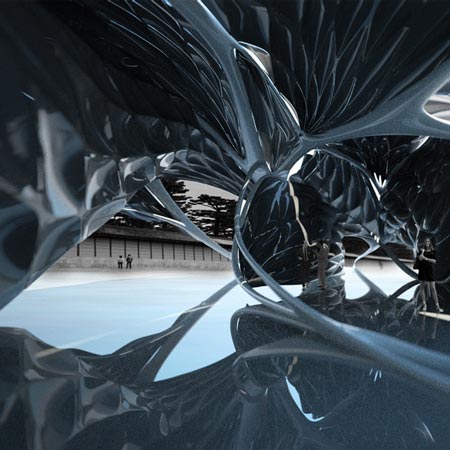Here's another student project, this time a pavilion designed by Alan Lu at the University of California.
The conceptual pavilion was designed for a fictional perfume brand and would be situated at the Imperial Palace in Kyoto, Japan.
The information below is from Alan Lu:
--
I am a forth year (last year) architecture student at University of California, Berkeley in the U.S. The work was done as part of a comprehensive graduate studio led by Peter Testa of Testa & Weiser, completed this fall (2008).
The brief for this project is a pavilion structure situated in the Imperial Palace in Kyoto, Japan for a fictitious perfume production company. The aim of the project was to explore the emergent structural morphology of rheological materials that could be applied to a series of nested bioclimatic envelopes in the form of a visitor pavilion. It serves as a departure point for research into membrane systems that are porous, microporous, layered, bubbled and/or foamed surfaces.
As an interface between the public and scent fabrication, the scent pavilion emerged from fluid simulations and branching networks. The project then evolved into a formal separation of scent synthesis and commercial sales within the pavilion. Operational envelopes composed of a double layered performative membranes create controlled climates while a fiber glass structure both stabilizes the structure and disperses scents to specific chambers, giving the public access to the art of scent making.
The program for the pavilion called for a series of small compact experimental growing chambers for plant materials from two distinct climate zones. Other required spaces included chambers for scent customization, a dark and thermally stable storage area, seating, display, and sales area. The separation of enclosed and open were thus defined by the material properties of the skin.
In addition to explorations in computational material forms and rheological materials, a second facet of the project dealt with thermodynamics - the consideration of form as responsive to the flow of energy and matter.
As a result, interior air quality and light modulation were under careful development and analysis to allow for distinct environmental conditions. There were also considerations about structural performance based on avoiding stress concentrations.

